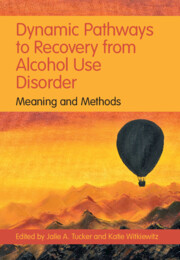Book contents
- Dynamic Pathways to Recovery from Alcohol Use Disorder
- Dynamic Pathways to Recovery from Alcohol Use Disorder
- Copyright page
- Dedication
- Contents
- Figures
- Tables
- Contributors
- Foreword
- Preface
- Acknowledgments
- Introduction
- Part I Micro Level
- Part II Meso Level
- 9 Natural Recovery from Alcohol Use Disorder
- 10 Individual Behavioral Interventions to Incentivize Sobriety and Enrich the Natural Environment with Appealing Alternatives to Drinking
- 11 Family and Social Processes in Recovery from Alcohol Use Disorder
- 12 Community-Based Harm Reduction Approaches for Alcohol Use Disorder
- 13 Use of Mobile Technology to Understand and Improve Recovery from Alcohol Use Disorder
- 14 Studying Recovery in the Social Context
- 15 Measuring Substance Use Contexts and Substance-Free Reinforcement
- Part III Macro Level
- Conclusions and Future Directions
- Index
- References
12 - Community-Based Harm Reduction Approaches for Alcohol Use Disorder
from Part II - Meso Level
Published online by Cambridge University Press: 23 December 2021
- Dynamic Pathways to Recovery from Alcohol Use Disorder
- Dynamic Pathways to Recovery from Alcohol Use Disorder
- Copyright page
- Dedication
- Contents
- Figures
- Tables
- Contributors
- Foreword
- Preface
- Acknowledgments
- Introduction
- Part I Micro Level
- Part II Meso Level
- 9 Natural Recovery from Alcohol Use Disorder
- 10 Individual Behavioral Interventions to Incentivize Sobriety and Enrich the Natural Environment with Appealing Alternatives to Drinking
- 11 Family and Social Processes in Recovery from Alcohol Use Disorder
- 12 Community-Based Harm Reduction Approaches for Alcohol Use Disorder
- 13 Use of Mobile Technology to Understand and Improve Recovery from Alcohol Use Disorder
- 14 Studying Recovery in the Social Context
- 15 Measuring Substance Use Contexts and Substance-Free Reinforcement
- Part III Macro Level
- Conclusions and Future Directions
- Index
- References
Summary
Community-based harm reduction for alcohol use disorder (AUD) entails a compassionate stance and pragmatic strategies that minimize alcohol-related harm and enhance quality of life. Community-based harm reduction approaches aim to meet people where they are both in their communities and with respect to their motivation for change. Harm reduction approaches do not require or prioritize abstinence or alcohol use reduction as the sole or most desirable recovery pathway. To date, community-based harm reduction approaches have been applied and investigated primarily within marginalized populations, particularly people experiencing homelessness and AUD. Randomized controlled trials have established efficacy for the low-barrier, non-abstinence-based Housing First approach and for community-based harm-reduction treatment. Managed alcohol programs and meaningful activities programming have shown promising findings in nonrandomized trials and warrant further study. The chapter concludes with reflections on key themes undergirding work in community-based harm reduction and how it has positively affected individuals and communities.
Keywords
- Type
- Chapter
- Information
- Dynamic Pathways to Recovery from Alcohol Use DisorderMeaning and Methods, pp. 218 - 238Publisher: Cambridge University PressPrint publication year: 2022



